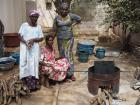April 2017 | Fact Sheet: CLIMATE CHANGE RISK PROFILE - WEST AFRICA SAHEL (pdf)
By USAID
The West Africa Sahel region is a semi-arid area that runs from the Atlantic Ocean eastward to Chad, separating the Sahara Desert to the north and the Sudanian Savana to the south. The region is one of the poorest and most environmentally degraded in the world, and is considered one of the world’s most vulnerable regions to climate change, as temperature increases are projected to be 1.5 times higher than in the rest of the world. Climate vulnerability is compounded by the region’s high dependence on rainfed agriculture and its natural resources to support food security and livelihoods, rapid population growth, and chronic humanitarian crises due to recurrent drought, flooding, food insecurity, epidemics, and violent conflict. The region is still recovering from the food crisis brought about by the severe droughts experienced in 2005, 2008, 2010 and 2012.
Data from 2015 suggest that over 20 million food insecure people and nearly 6 million malnourished children live in the Sahel. With substantial population growth (average 3 percent per year) and recurring challenges linked to environmental degradation, pervasive poverty and political instability, climate change in the Sahel will compound existing vulnerabilities. Water scarcity, longer dry seasons and impacts of higher temperatures may trigger new conflict and forced migration, issues that already impact the region. This fact sheet focuses on five countries: Burkina Faso, Chad, Mali, Mauritania, and Niger.




